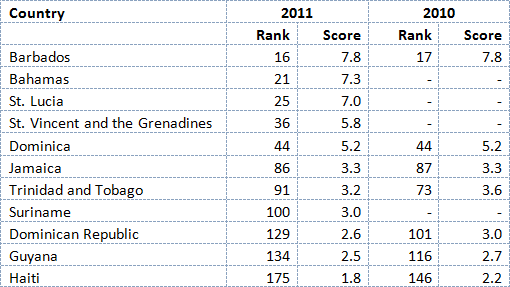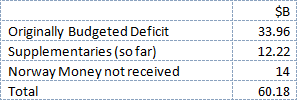Introduction
December 9 was an important day for Guyana. For the first time since 2003 when the United Nations designated the day as International Anti-Corruption Day to raise awareness about corruption as an international and domestic agenda issue, the day was marked with a public activity – a seminar – in which the Government of Guyana took part. While President Ramotar could not be present his administration was represented by re-appointed Finance Minister Dr Ashni Singh who made a full-length presentation on behalf of the government, and Ms Gail Teixeira.
The event was sponsored and hosted by Transparency Institute Guyana Inc and its directors succeeded in having Ms Zoe Reiter, a senior programme officer of Transparency International come especially for the occasion to make a presentation. Ms Reiter used the occasion to launch formally the Transparency International’s 2011 Corruption Perception Index (CPI). She did not bring good news.
Guyana falls
The CPI ranks countries according to their perceived levels of public-sector corruption using a simple form of indexing to arrive at a score ranging between 0, perceived to be the most corrupt, and 10, perceived to be the least corrupt. The 2011 index draws on different assessments and business opinion surveys that are carried out by independent, reputable institutions. The surveys and assessments that are used to compile the index include questions which relate to the bribery of public officials, kickbacks in public procurement, embezzlement of public funds, and questions that probe the strength and effectiveness of public sector anti-corruption efforts.
Guyana was first included in the CPI in 2005 and in 2010 was ranked at number 116. It plummeted to 134 this year. By comparison our Caribbean neighbours were ranked as follows:
Three of the Caribbean countries are included for the first time: the Bahamas, St Lucia, St Vincent and the Grenadines, and Suriname.
Not wealth nor size but systems
Wealth seems no easy antidote to corruption; some relatively rich countries, including Russia, fall at the bottom of the global league table. Meanwhile, some of the world’s poorer states do comparatively well: Botswana, Bhutan, Cape Verde, and Rwanda all appear among the 50 “cleanest” countries.
Nor is size a major issue either. Many of the smaller island states are in the top half of the corruption ladder while many larger countries are in the bottom half. What seems clear is that those countries with strong systems, independent institutions, modern laws and effective enforcement are likely to be at the head of the line.
New Zealand, a country that has shown a willingness to help Guyana develop systems for better parliamentary governance, occupies the top spot with a score of 9.5 followed by Finland and Denmark. The countries that occupy the bottom ranks in the index are Somalia, North Korea, Myanmar and Afghanistan, which are helmed by unstable governments and conflicts.
Jagdeo’s basket
In terms of corruption, the final year of the Jagdeo administration was not a good one for Guyana or for the PPP/C government. It was dominated by scandals surrounding persons high up in the administration being associated with deals involving state lands, containers, and shady characters. We saw too, the continued inability of the government to bring into operation the Public Procurement Commission, a failure that allows Cabinet to have the final word in contract awards. And it was too the year in which the excesses of the Former Presidents (Other Benefits and Facilities) Act were put under a harsh spotlight and the misuse of state resources for partisan purposes assumed new heights.
It is difficult to tell whether those revelations had any impact on Guyana’s decline but the news confronted Mr Jagdeo’s successor President Donald Ramotar, with both an obligation and an opportunity to establish the first marker on his administration’s attitude to corruption. As stated above, Mr Ramotar delegated that role to his Finance Minister and the abrasive Ms Teixeira. If it was intended to be a clear signal for change, Dr Singh failed both in substance and in style, alienating many if not the entire audience. It is unlikely that if Dr Singh appreciated the significance of November 28, 2011 or the concerns sweeping the world about corruption, from India to the EU countries, Brazil and Russia, that he would have been so hubristic in his reaction to responses and questions from the floor.
Missing the message
Dr Singh might have missed too that Transparency International (TI) chair Huguette Labelle recently pointed out that, “This year we have seen corruption on protestors‘ banners be they rich or poor. Whether in a Europe hit by debt crisis or an Arab world starting a new political era, leaders must heed the demands for better government.”
One wonders how someone as bright as Dr Singh could fail to understand that to continue doing exactly as he did under the Jagdeo administration was neither an option nor wise.
In what was programmed for a 15 minute presentation, Dr Ashni Singh spent no less than forty minutes in a criticism of the methodology used by Transparency International in constructing the CPI and in telling the overseas guest and the diplomatic community about the unrecognized and unacknowledged efforts by the PPP/C administration to deal with corruption. It was all about the significant changes to the constitution during the Jagdeo presidency, the many select committees of the National Assembly, the best Procurement Act in the world and the tremendous strides made in the Audit Office.
Dr Singh seems to have ignored the logic that if the methodology is weak for one it is no different for the others, and that whatever he may think of the CPI it is closely watched by investors, economists, and civil society campaigners and the international financial institutions. He might have noted too the direct comments from the head of the European Union that the EU as a major donor to Guyana is paying close attention to how concerns about corruption are addressed.
The future, not the past
From the floor I pointed out to the Minister that three months ago Ms Gail Teixeira had regaled a TIGI launch ceremony with the same information but only in a slightly more abrasive manner. For the majority in the audience, those acheivements were about the past while their interest was in the future. In other words, the current interest is whether the Ramotar administration would treat with corruption any differently. For Dr Singh – and I guess he intends for all of us – the future would be a continuation of the work-in-progress.
Perhaps Dr Singh’s most ironic and astounding claim was the enhancements in the Audit Office and the number of staff they now have. It was a case of ‘never mind the quality, feel the width.” I could not publicly and in that forum remind the Minister of the lack of appropriate qualification of the holder of the top post in that office, the unprecedented lack of independence of the holder of the second most top post and the fact that both were acting in their positions!
Maybe he should speak with Greg Christie, Contractor General of Jamaica which scored 3.3 out of 10. Mr Christie called on Jamaicans to demand major changes or face stagnation and in language that resonated in the southern-most Caricom state, Mr Christie said, “It should now be abundantly clear to all Jamaicans that unless they demand monumental changes in the country’s existing moral, ethical and legal anti-corruption codes, and in its approach to the co-joint issues of transparency, accountability and good governance in the administration of the affairs of the Jamaican state, 10 years from now we will still be at the same place, talking about the same things.”
So what can we do? Here are some obvious steps:
1. re-constitute the Integrity Commission;
2. constitute the Public Procurement Commission;
3. revamp the Audit Office, replace the head and deputy head, remove the Office from the financial controls of the Minister of Finance and modify the processes and procedures by which it conducts its audits;
4. strengthen the Public Accounts Committee of the National Assembly, widen its mandate and ensure that it is properly resourced and has access to independent professionals;
5. repeal and replace the Access to Information Act with one that brings in sunlight and that provides for protection for whistleblowers;
6. introduce anti-corruption legislation;
7. replace the expired Commissioner of Police and set up a strong anti-corruption unit in the Guyana Police Force;
8. punish in the court without fear or favour showing no mercy, those who feel it is their right to steal from society.



